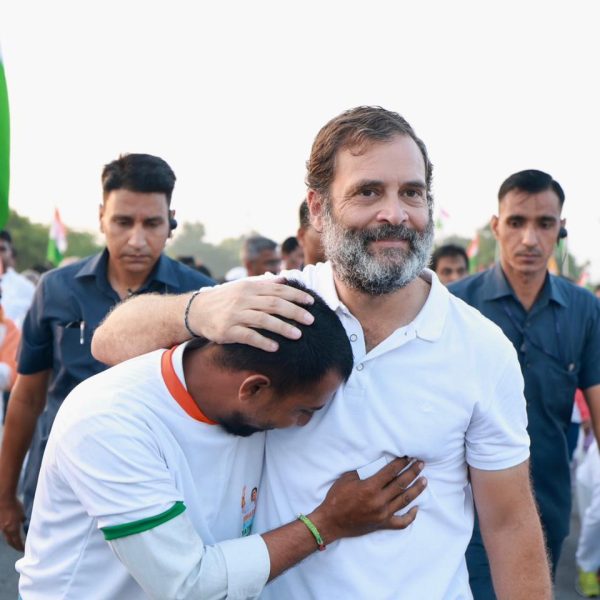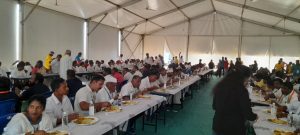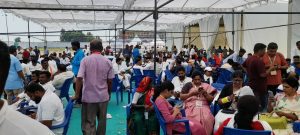
Bharat Jodo Yatra: Planned and executed to the last-minute detail
Right from providing water bottles every 2 km to segregating dry and wet waste produced during the yatra, a lot of thinking seems to have gone into planning Rahul Gandhi's 150-day walk

A lot of planning seems to have gone into the Rahul Gandhi-led Bharat Jodo Yatra (BJY), which is connecting the grassroot party workers to the party mainstream and boosting their morale.
This writer travelled along with the BJY for around 40 km, from Mantralayam to Raichur. In the blazing heat, a profusely sweating Rahul’s brisk walk motivated his supporters and thousands of party workers. Equally evident was the strategic plan behind the yatra, which Team Rahul has been managing meticulously, well in advance.
The trip from Raichur
Normally the yatra starts at 6.30 in the morning and ends at around 7 in the evening with a break between 11.30 am and 4 pm. The heat in Raichur, though, forced an early start at 6 am.
Also read: Bharat Jodo Yatra: Braving heat, terrain, Rahul on image makeover mission
Around 120 Bharat yatris and around 400 Karnataka yatris (every state Congress unit has its yatris), walked with Rahul. Prominent state leaders, including DK Shivakumar and Siddaramaiah, have joined in recent weeks. All through the day, Rahul chatted with police personnel, farmers, villagers, children, etc. Sometimes he would suddenly visit a small house on the road, or go to a cotton field and sit.
Food, water arrangements

Local Congress leaders, MLAs and MLA aspirants had made arrangements to give half-litre water bottles to the thirsty yatris after every 2 km. When the yatra reached the camp at around 11 am, water and food were in place for the walkers. For the party workers and public, food arrangement was done by local leaders outside the camp. There were also separate food arrangements for party office bearers, members, volunteers, leaders and Bharat yatris inside the camp canopies. A strict menu is followed for the Bharat yatris so that their health is not affected.
For Rahul and other senior leaders, a separate canopy was arranged, where he had his specialised diet, planned to keep him fit throughout the five-month yatra. While resting at the camp, Rahul would often interact with groups of farmers, retired government employees, civic workers, retired sainiks and so on, said party workers.
For the afternoon halt, around five canopies were put out, and these were a beehive of activity – leaders meeting each other, discussions among office bearers, party workers connecting with their leaders, small press conferences, party workers wishing each other, and so on. The Bharat yatris and Karnataka yatris had their lunch and rest on one side. All the canopies resembled buzzing conference halls.
Canopy rotation
The BJY is possibly the first of its kind for a political party and is providing an opportunity to party workers, and low, middle-level and big leaders to connect with each other. Some leaders utilise the occasion to have a kind of round-table discussion on various subjects.
When the yatra for the day ended at around 7 pm, the canopies saw impromptu corner meetings and brief speeches for the party workers and the yatris, mainly by Rahul. Food and other basic facilities were also arranged. Meanwhile, the frames, beams and canopy supports of the first half were shifted to the next day’s afternoon camp. Similarly, when Rahul started his march in the morning, the canopies of the previous night were shifted for the next day’s evening preparations.
Shifting banners

Flex banners and hoardings lined both sides of the road that Rahul took that day. Some were in English, but most were in Kannada. There were also banners of local leaders.
Interestingly, once the day’s 25-km stretch was over, all the flexes and banners, except those of local leaders, were taken down and put up on the 25-km stretch to be walked the next day. Organisers said that once the BJY crossed Karnataka and entered Telangana on Sunday, the content sheet of the flexes would be changed from Kannada to Telugu. To carry the frames and supports and the banners, separate trucks were used.
At the same time, ‘Green yatris’, arranged locally, picked up plastic bottles and other waste on the roadsides of the yatra and at the camps and later helped in segregating dry and wet waste. This was to make sure the burden of waste management did not fall on the local bodies.
Planning team

A team of Randeep Singh Surjewala and local leaders planned for Rahul’s next day and his ‘walk the talk’ with well-known personalities, farmers, children, etc. Rahul’s stay with villagers during the yatra was arranged by Surjewala’s team, keeping in mind the security norms. Many times, Rahul met people or chatted with students and children spontaneously but the security personnel kept a close watch on the goings on.
Also read: Bharat Jodo Yatra: Rahul is walking into India’s hinterlands and hearts
The planning for the Bharat Jodo Yatra is mainly done by leaders including Digvijay Singh, Surjewala and Jairam Ramesh, a party leader said. The work is evenly distributed among leaders and state office bearers of the party.
KPCC chief DK Shivakumar told The Federal that each and every work was allotted to specific leaders and that was precisely what was helping make the Bharat Jodo Yatra a success.


